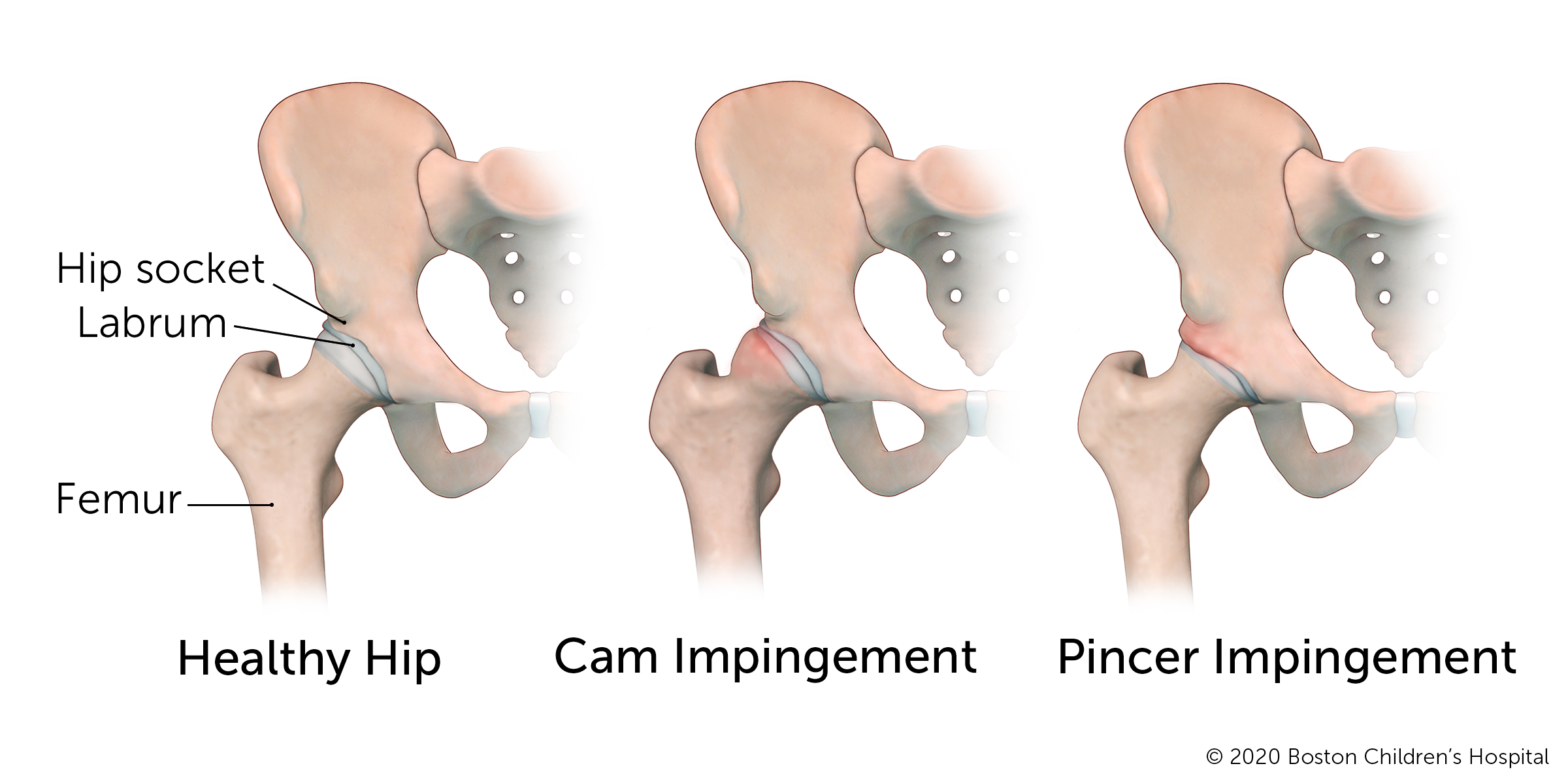Hip Impingement | Symptoms & Causes
What are the symptoms of hip impingement?
Some people with a hip shape that may cause impingement may never experience pain or other symptoms. Others, especially people who are active, develop symptoms as early as their teens. If and when symptoms appear, they are usually a sign that the labrum or cartilage has been damaged.
If your child has symptomatic hip impingement, early diagnosis will give them the best chance of a successful recovery and full return to activities, including sports.
Signs and symptoms of hip impingement can include:
- pain in the groin or hip
- pain from activity (such as sports or dancing) or prolonged sitting
- difficulty flexing the hip
- limping
- popping or clicking of the hip
- stiffness in the groin or front of the thigh
What causes hip impingement?
No one knows what causes an abnormal bone shape that may lead to hip impingement. The abnormal bone shape that may cause impingement likely develops as a child’s hip joints develop over time. Doctors and researchers don’t know what causes this to happen.
Sometimes, hip impingement is caused by other hip conditions, such as slipped capital femoral epiphysis (SCFE) and Legg-Calve-Perthes disease.
Although physically active people often develop symptoms sooner than less active people, exercise does not cause hip impingement.

Meet Louise
Hip impingement and dysplasia forced the track star to give up running. Her surgeon printed a 3-D model of her hip joints to better understand and correct the irregularities causing her pain.
Hip Impingement | Diagnosis & Treatments
How is hip impingement diagnosed?
Your child’s doctor or hip specialist will start by asking for a full medical and family history. They will want to know about any hip problems any members on either side of your family have had.
A physical exam will help rule out other causes for your child’s hip pain. The exam will include an impingement test, during which the doctor will raise your child’s knee toward their chest and rotate the knee inward. If this or other motions cause pain, hip impingement is the likely cause.
To confirm the diagnosis, the doctor will order images of the hip joint and the area around it. This may include one or more of the following tests:
- X-rays can rule out a fracture or other injury. They can also show the shape of the hip socket and top of the thigh bone, and whether either one appears abnormally shaped.
- CT scans (or CAT scans) use x-ray technology to produce even more detailed images of the hip area and any damage caused by impingement.
- MRIs can show a clear picture of the amount of damage to the hip joint and other parts of the hip, such as cartilage or ligaments. It also helps doctors determine the stage of an injury.
In addition to diagnosis, doctors often use these images to design a plan for treatment.
What are the treatment options for hip impingement?
Your child’s treatment for hip impingement depends on several factors:
- type of impingement
- extent and severity of damage
- your child’s age
- overall health
- medical history
Less severe cases of hip impingement may be treated without surgery. If your child’s hip impingement is severe, the doctor will likely suggest surgery.
Non-surgical treatment options
For many children, the first step is to rest the hip by taking a break from sports and other activities that cause hip pain. Rest is often combined with over-the-counter pain medicine such as ibuprofen to reduce inflammation.
Physical therapy (PT) might also be a part of your child’s treatment. PT helps build strength in the muscles around the hip.
If your child is still in pain after rest, ibuprofen, and PT, their doctor may suggest a shot. The shot is given inside the joint and contains a numbing medicine combined with a steroid. If the pain still doesn't go away, the doctor will discuss surgery.
Hip impingement surgery
The most common type of surgery for hip impingement is arthroscopic, a type of minimally invasive surgery.
The doctor makes two or three small incisions, then inserts a thin scope to see the joint and repair the hip. The repair may include fixing the labrum or cleaning up torn cartilage. The surgeon may also reduce friction between the head of the thigh bone and the socket by removing some bone.
Some patients go home the same day as the surgery. Others spend a night in the hospital.
If the hip can’t be repaired with minimally invasive surgery, your doctor may recommend an open surgery. This procedure requires a larger cut to expose the area that needs to be repaired.
For the first two to three weeks after surgery, your child will need to walk with crutches. They may also need PT to help restore muscle strength and range of motion. Most children can return to full activity, including sports, within three to four months.
How we care for hip impingement
The Child and Young Adult Hip Preservation Program at Boston Children’s Hospital provides world-class care for patients of all ages. We tailor our care to the needs of teens, starting with a thorough exam. We use MRI techniques developed jointly with the Department of Radiology to diagnose the condition and reduce our patients’ future risk of osteoarthritis. Whenever possible, we take a non-surgical approach to treatment. However, if surgery is called for, our surgeons are pioneers in minimally invasive arthroscopic surgery.
Patient resources
Download our hip impingement fact sheet to learn more about the condition, how it occurs, and how the specialists in our Child and Young Adult Hip Preservation Program approach care.


